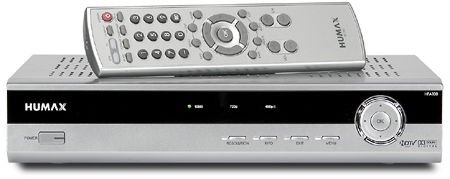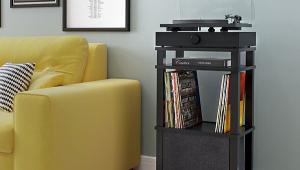Humax HFA 100 Digital Tuner

The number of companies selling stand-alone digital tuners has also dwindled. But now a new company has entered this market, even as it slowly shrivels: Humax, a relatively young Korean company that broke into the American market only recently. Like Samsung, another Korean company, Humax is offering a diminutive but fully featured digital tuner at the can't-beat list price of $229. Already I am seeing it for sale on line for under $200.
The closest competitor in price I have seen is Samsung's SIR-T451, which offers similar features. But the lowest price I have found online is $249. I reviewed a Samsung digital tuner a couple of years ago, but it would not be fair to assess it in comparison to the new Humax, as I am sure that Samsung has changed/improved their models in the time since I looked at it.
The Humax is a plain-Jane device that is only 12 inches wide and 2.5 inches high, and it weighs just four pounds. The front panel is silver and black with the requisite controls for basic functions. On the rear are the normal composite, S-video, and component outputs as well as RGB and HDMI jacks. The programmable remote is fully featured and easy to use, but not backlit.
Depending on your display, it can provide a signal in any of the normal formats: 480i, 480p, 720p and 1080i. A button on the front panel lets you select among the options. Oddly, there is no similar button on the remote.
The receiver also provides rudimentary aspect-ratio control, allowing you to watch a 4:3 show on a 16:9 screen just as it was presented or stretched or zoomed (and cropped). It does not offer the best option, sometimes called "custom stretch," which keeps the center of the image mostly intact while stretching the edges. But remember, this receiver costs just over $200.
Setup is straightforward. An installation menu guides you through basic questions such as time zone, menu language, etc. It eventually leads to the last step: channel scan. Here the receiver searches for digital signals and memorizes them. For many years, this was the most variable feature of any digital tuner; some were definitely better than others. Only a few in the early years could receive all the digital channels without problem.
I have a rooftop antenna with a direction rotor. And my unvarying method of testing receivers, from the first Panasonic receiver I reviewed in October 1998, is to orient the antenna in the middle position between the ideal locations for each of the eight broadcast channels here in Washington D.C. Then I run the channel scan and see how many channels the receiver can pick up.
As always, I must point out that your results may be different than mine. In your home, this receiver may be more or less sensitive, depending on the type of antenna you are using, the distances between the antenna and the transmitters, and the topography of the terrain in between, among other variables. But my setup lets me judge each new receiver using exactly the same criteria.
I am happy to report that the Humax was able to receive all 11 digital channels on the air when I performed the test. The number of available channels varies because some stations multicast during part of the day. For example, the local NBC and ABC affiliates run a weather channel with temperatures, weather conditions, and a weather radar image on the second channel during the day. It's a relatively static but useful way to use the channel. In any case, the Humax was able to receive everything from the rooftop antenna.
Then I tried something else. In a room upstairs, I have a Terk TV25 indoor antenna sitting atop an armoire. A few months ago, I bought a new television for the room, Sony's KD-36XS955 direct-view HDTV with a built-in digital receiver. After installing it, I hooked up the Terk antenna to see what I could see. Years earlier, I used that antenna to test receivers, but the results were so disappointing that I stopped. I was usually able to receive one or two channels, if that.
Well, to my surprise, the Sony's channel search was able to pick up all 11 channels using the indoor antenna. The TV was not always able to display all 11, and the picture was not always rock-solid. (A digital picture is either perfect, or it freezes, breaks into digital blocks, and disappears.) But I was able to watch several games during the NCAA basketball tournament last month in HDTV—on the Sony with an indoor antenna.
When I got the Humax receiver, I tried it with the Terk, connecting the component output to the Sony. After a channel scan, the Humax picked up eight of the 11 channels—not perfect but still quite good.
Once the channel information is recorded, the receiver offers a very limited program guide. Since the box does not have an analog receiver and cannot accept a cable signal, the guide shows only the digital channels it has found. When you select one, it presents a familiar banner for a few seconds that shows whatever descriptive material the station is providing on the show in progress, including a bar-graph display indicating how much of the show has already aired and how much remains.
If you press the Info button on the remote, the banner presents more information, such as what sort of signal you're watching (480p, 1080i, etc.). It would be more convenient if it showed all the information at once without having to push a button to call up more.
The HFA 100 offers all the options that have become standard on new TVs and receivers. You can customize the banner, set a password for access to the programming, and change the caption font size, color, etc.
All in all, the Humax HFA 100 provides everything you need to receive free, over-the-air high-definition programming reliably, conveniently, and at a price you cannot beat.
Highs and Lows
Highs
• Cheap and effective
• Easy setup
Lows
• DTV only; no SDTV or cable reception
• Rudimentary program guide






























































